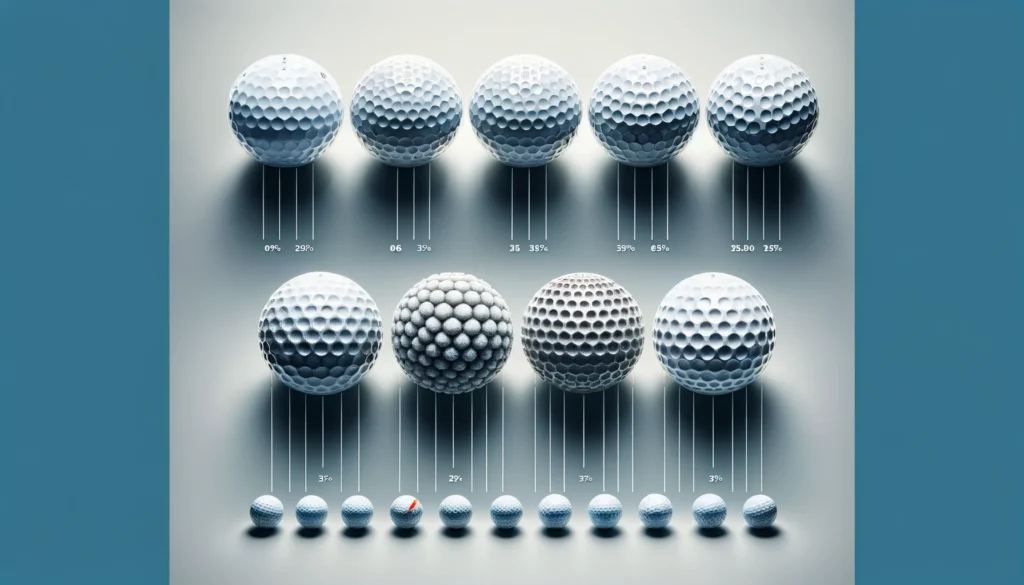Have you ever caught yourself staring at a golf ball and those little dents on it? Yep, those dimples. Pretty interesting, right? They’re not just for looks. Those dimples are like a secret weapon that makes the golf ball fly far and true.
I remember one day on the course, holding a ball and wondering about those tiny, precise dimples. Turns out, they’re super important for the ball’s flight, speed, and how it plays on the course. It’s not just a random design; it’s all about aerodynamics, making golf that much more exciting.
So, why are dimples so fascinating? They make a huge difference in how the ball moves through the air. Whether you’re new to golf or have been playing for years, the science behind these dimples is something worth knowing.
It’s not just about how many there are, but how they help the ball zip across the course. Join me in this little adventure as we dive into the world of golf balls and discover the magic behind those dimples. Trust me, it’s a journey that’ll make you see your golf ball in a whole new light!
The Science of Dimples
Dimples are pretty much the unsung heroes of golf, making sure the ball flies far and true. It all boils down to aerodynamics, the science of air in motion.
While a smooth ball would quickly slow down due to drag, a dimpled ball beautifully cuts through the air, thanks to those tiny indents creating turbulence.
This turbulence is a good thing; it helps the ball stay airborne longer by reducing drag and adding a bit of lift.
But here’s the kicker: those dimples aren’t just slapped on randomly. Golf ball makers have been perfecting their designs for ages, tweaking each dimple’s size, depth, and overall pattern to get just the right performance out of every swing, no matter the weather or course.
Next time you’re about to hit the green, take a moment to appreciate that little ball.
Every dimple on it is a piece of science and art, crafted to boost your game. Isn’t it amazing how something so small can have such a big impact on how we play?
Dimple Count Variations: Let’s Talk Numbers

Diving deeper into our chat about golf balls, let’s zoom in on those dimples. Ever caught yourself wondering about the number of dimples on a golf ball while you’re gearing up for a swing? Turns out, the count can vary a lot, from 300 to 500 dimples!
Yep, no one magic number fits all, and here’s why: golf ball designers are like meticulous artists, tweaking dimple counts to get just the right flight behavior.
Whether it’s 336, 344, or 392 dimples, each design is crafted to cut through the air just right, giving you that perfect blend of distance and control.
So, why all the variation? It’s all about matching the golf ball to your play style and the day’s conditions. Those dimples are key players in making sure your ball flies true to your game.
Next time you’re picking out a ball, think about those dimples as your little helpers, each one working to make your game better. It’s a cool reminder of how innovation keeps making our favorite sport even more enjoyable.
Impact of Dimples on Golf Ball Performance
Dimples are game-changers, literally making the ball zoom through the air.
It’s all thanks to aerodynamics – that’s just a fancy way of saying how air moves around things. Without getting too sciency, those dimples make the air work in the ball’s favor, letting it fly higher, faster, and more accurately than a smooth ball could ever dream of.
It’s not just about slapping on as many dimples as possible, though. Golf ball creators have found a sweet spot, usually between 300 to 500 dimples, to make sure the ball performs its best, balancing drag and lift like a pro.
So, next time you’re picking out a ball, think of those dimples as your little helpers on the green. They’re not just for looks; they’re carefully designed to improve your game, ensuring your ball travels where you want it to.
While the exact number of dimples might vary, the right design for your style can make a difference. Remember, it’s those small details that can give your game a big boost.
The Evolution of Golf Ball Design

Ever wondered how golf balls got those signature dimples? It’s quite the tale, blending history, science, and a bit of accidental genius. Picture this: the earliest golfers playing with smooth balls, only to find them lacking in flight and predictability.
But as these balls got nicked and dented, something cool happened—they started flying farther and more true. This sparked a revolution in golf ball design, leading to the dimple-packed beauties we use today.
These dimples, believe it or not, are the secret sauce to a ball’s flight. They cut through air resistance and give the ball lift, letting it soar across the fairway. Over time, designers have tweaked and tested dimple sizes and patterns, all to get that perfect flight. It’s a mix of art and science, aiming to give every golfer the edge they need.
Next time you’re out on the green, give your golf ball a closer look. Those dimples are more than just decoration; they’re a testament to innovation and the relentless pursuit of the perfect game.
It’s a reminder of how even the smallest details can have a huge impact on how we play and enjoy sports. So here’s to the dimpled golf ball – a small marvel of engineering that carries the spirit of the game.
The Regulatory Standards of Golf Ball Dimple Design

Diving into the world of golf balls, have you ever wondered about the rules shaping those signature dimples? It’s more than just design; it’s about sticking to some pretty specific standards to keep the game fair.
The USGA and R&A play a big role here, setting the stage without dictating the exact number of dimples. They’re focused on the ball’s overall performance, like its size, weight, and how it flies.
This means brands get to be creative, experimenting with dimple designs to enhance how the ball moves through the air, all while making sure they don’t cross the line of what’s allowed. You’ll see golf balls boasting anywhere from 300 to 500 dimples, each tailored to improve your game within the rules.
So, when you’re holding a golf ball, think of it as a masterpiece of engineering, designed not just to look good but to offer you the best play possible within the sport’s cherished guidelines. It’s a perfect blend of innovation and tradition, ensuring that as the game grows, it remains the game we love.
The Design Process: Choosing the Right Dimple Count
Chatting about golf balls, ever noticed those dimples and wondered why they vary so much in number? Turns out, it’s all part of a grand design, not just random or for looks.
The big bosses of golf rules, like the USGA and R&A, don’t pin down an exact number of dimples you need to have on a golf ball. Instead, they’re all about how the ball performs, focusing on size, weight, and how far it flies.
This leaves the door wide open for manufacturers to get creative, aiming to craft a ball that flies perfectly, whether it has 300 or 500 dimples.
So, when companies decide on how many dimples to put on their balls,
it’s a mix of science, a bunch of testing, and yes, a sprinkle of magic. They’re on a mission to find the “just right” count that makes the ball cut through the air like a knife, ensuring it lands right where you want it.
This isn’t a one-answer-fits-all kind of deal; it’s about precision engineering to make sure your ball does its best work for you on the course. Next time you’re about to hit the green, think about the genius and care packed into those dimples, all there to help you nail that perfect swing.
Brand-Specific Dimple Designs
It’s pretty cool how each golf ball brand brings its flair to those dimples, making each one unique. It’s not just about looking different; those dimple designs are all about boosting the ball’s performance.
Whether it’s adding more dimples for stability, playing with their shapes for better control, or tweaking their depth to cut through the air, each tweak has a purpose.
Like, one brand might aim for shallower dimples to help you whack the ball further down the fairway.
Meanwhile, another could focus on a pattern that gives you that chef’s kiss of spin control when you’re aiming for the green.
Next time you’re in the market for new golf balls, give those dimples a second glance. They’re not just random; they’re a major part of the ball’s tech, tailored to help you up your game.
It’s amazing to think about the strategy and science packed into each little dimple, proving there’s a whole lot more to golf balls than meets the eye.
Conclusion
Wrapping up our chat about golf balls, it’s amazing to see how much those tiny dimples matter, right? They’re not just there to make the ball look cool; they’re crucial for making it fly straight and far. We’ve seen that these dimples are all about beating air resistance and helping the ball go the distance.
The cool part is how golf gear makers are always coming up with new dimple designs to make our game better. They play around with different counts, shapes, and patterns, all to give us balls that fit just right with how we play, whether we need more control or more oomph in our shots.
So, it turns out those little dimples are a big deal. They show just how smart and creative folks have gotten with golf technology, mixing old-school know-how with new science to keep improving our favorite game. And you can bet they’ll keep tweaking and testing, making sure we’ve always got the best tools to take on the course.
FAQ
1. Why do golf balls have different dimple counts?
Answer – Dimple counts vary because each golf ball is designed with a specific goal in mind. Whether it’s achieving longer distances, better control, or optimal flight stability, manufacturers tweak dimple counts to enhance performance. The variation in dimple counts, from 300 to 500, allows for a range of balls suited to different playing styles and conditions.
2. What’s so special about the Titleist Pro V1?
Answer – The Titleist Pro V1 is a favorite among golfers for its exceptional balance of distance, consistency, and control. This ball is designed to deliver high performance for players of all skill levels. Its popularity comes from the meticulous engineering behind its dimple design, which optimizes flight and feel. The Pro V1’s success lies in its ability to meet the needs of serious golfers seeking precision and reliability on the course.
3. Is there a significance to having 336 or 366 dimples?
Answer – Yes, specific dimple counts like 336 or 366 are the result of extensive research and testing. These numbers aren’t arbitrary; they represent a design that manufacturers have found to offer optimal aerodynamic properties. For example, a ball with 336 dimples might be designed to provide a stable flight and good lift, while one with 366 dimples could be aimed at reducing drag for longer distances. Each dimple count reflects a balance between reducing air resistance and maximizing lift to suit different playing preferences.

Welcome to DriveToWinGolf.com! I’m Netranand Meshram, the passionate golf enthusiast behind this blog. My journey in the world of golf began as a keen observer, drawn to the sport’s skill and elegance. This fascination blossomed into a deeper appreciation, inspiring me to create a space where fellow golf lovers, whether beginners or seasoned players, can share insights and celebrate the game. At DriveToWinGolf, we delve into the nuances of golf, offering tips and stories that resonate with every golfer’s journey. Join me in exploring the captivating world of golf, one swing at a time!

